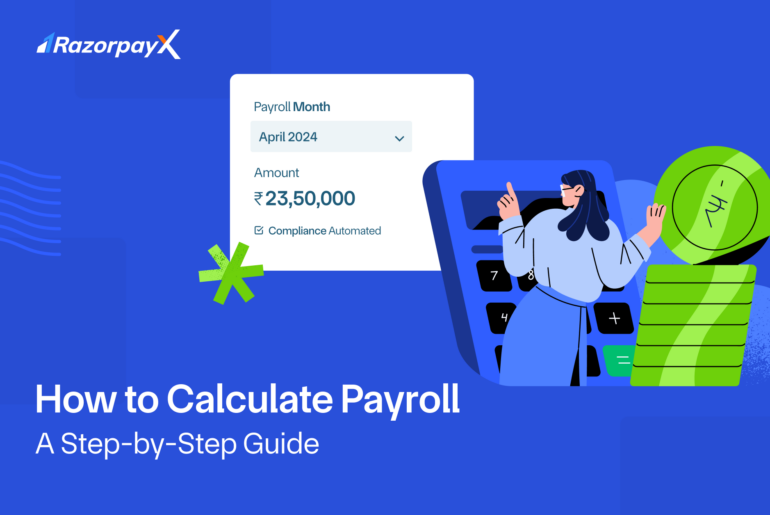Table of Contents
How to Calculate Payroll
Calculating payroll accurately and on time is incredibly important for any business. Incorrect or delayed payroll may result in disgruntled employees, fines or even legal action.
Manual payroll can be a good fit for small businesses with just a few employees and stable growth. It allows business owners to manage payroll without extra software costs. However, this approach becomes impractical for medium to large or even small businesses with significant growth.
Here’s a detailed guide on how to calculate payroll, with information on tax deductions, compliances and more.
Manual Payroll Processes – Best Practices
Before manually calculating payroll, follow these best practices to ensure smooth and error-free processing.
- Document everything. Maintain accurate employee records with up-to-date information and verified documents. This information will come in handy in case of any future conflicts or audits.
- Stay updated on tax regulation changes. Compliance and tax regulations change frequently, so it’s important to stay abreast of them so your business is 100% compliant and you can avoid any fees or penalties.
- Use a dedicated payroll system, even if it’s manual. Use tools like spreadsheets or physical planners to track and organize calculations. This helps organize calculations and reduces the risk of errors with a regular spreadsheet.
- Back up all your records. The biggest risk to maintaining manual records of payroll is damage or mishandling. In case of lost or damaged records, have a backup system in place, like paper copies or digital backups.
- Reconcile Accounts Regularly: To identify any discrepancies, compare your payroll records with bank statements and tax reports.
- Consider Outsourcing When Necessary: Managing payroll might become overwhelming for fast-growing businesses. Consider outsourcing payroll to a professional payroll service or using an automated or digital payroll solution.
How to Calculate Payroll Manually
Here is a comprehensive list of the steps to follow when calculating payroll manually.
Collect Employee Information
The first step is collecting the following employee information. You can store the information on a spreadsheet like Google Sheets or Microsoft Excel.
Financial Information |
|
| Bank Details |
|
Identification Information |
|
| PAN Card (India Only) | 10-character alphanumeric code for tax filing |
| Aadhar Card (India Only) | 12-digit unique identification number |
Compensation Details |
|
| Base Pay | Fixed amount of salary before deductions per pay period |
| Flexible Benefit Preferences | Employee choices for benefits (health insurance, etc.) |
| Insurance Premiums | Employee-paid insurance deductions from salary |
| Provident Fund (PF) Deductions (India Only) | Employee & Employer contribution percentages |
| Other Deductions | Authorized deductions (union dues, garnishments) |
Timekeeping Information |
|
| Timesheets | Record of hours worked, overtime, and leave taken |
| Unpaid Leaves Taken | Record of any unpaid leave (sick leave, vacation days) |
Determine Pay Period
Once employee information is collected, the next step is to calculate the number of hours the employee worked throughout the period. If your payroll cycle is one month, track the number of days and hours your employees worked in that month.
Most businesses use time and attendance tracking systems to record hours and days worked by employees. If calculating manually, take the following variables into account:
- Days worked in a month (including paid leaves)
- Hours worked in a day
- Unpaid leaves
Calculate hours worked in a month with the following formula and record hours for each employee on a spreadsheet, preferably the same spreadsheet with other employee information.
Total Hours Worked = (Days Worked - Unpaid Leaves) * Hours Worked per Day
Calculate Gross Pay
Gross pay can be calculated by multiplying time worked with base salary. For wage workers, hourly pay is multiplied with number of hours worked in a day.
For salaried employees, multiply total salary with the days worked in a month. Make sure to add special allowances like House Rent Allowance, Conveyance Allowance, etc, if applicable.
This final amount becomes the base for all other deductions, after which the net pay is finally determined.
Calculate Taxes and Other Deductions
At this stage, calculate the total tax to be deducted from the gross pay. Here are the steps to find deductible tax:
- Determine tax regime: India offers two tax regimes for individual taxpayers: the old tax regime and the new tax regime. Employees can choose their tax regime based on their investments and salary structure – make sure to record each employee’s preferred tax regime.
- Subtract exempt income: Certain incomes are exempt from taxation, like income from certain types of mutual funds or house rent allowances. Deduct these from the gross pay to arrive at the final taxable income amount.
- Apply tax slabs and rates: Based on the chosen tax regime and the calculated taxable income, identify the applicable tax slab and rate and calculate the income tax amount payable by the employee.
- Other deduction: In addition to taxes, there might be other deductions like Employee Provident Fund (EPF) contributions (shared by employer and employee) and professional tax (varies by state).
- Total deductions: Calculate the total deductions by adding the taxes and other deductions.
Calculate Net Pay
Net pay can be calculated by subtracting all deductions from the gross pay. Make sure to document all calculations meticulously for both compliance and employee transparency. Employers are legally required to provide payslips to all employees for transparency and meet legal requirements for employee record-keeping.
Here are the details employers need to provide in a payslip:
- Employee’s name and designation
- Pay period
- Gross pay
- Breakdown of deductions (taxes, EPF, etc.)
- Net pay
Disburse Payroll
Disbursing payroll is the final step, where you deliver the calculated net pay to your employees. Accuracy and timeliness are crucial here. Ensure you have sufficient funds available to cover all employee net pay amounts in your designated payroll account.
You can choose between paper checks, which are traditional but time-consuming, or direct deposit, a faster and more secure option that electronically transfers funds directly into employee bank accounts.
Automated Payroll Processes
Carrying out the entire payroll process manually can be incredibly time-consuming and prone to errors. Automating payroll brings significant time and cost savings for any business. RazorpayX Payroll is India’s only fully-automated payroll and compliance solution, with 45+ HRMS integrations to streamline your entire HR workflow.
FAQs
What is the formula to calculate payroll?
There are a number of formulas involved in the calculation of payroll. Gross pay can be calculated with the formula: Gross Pay = Hours worked x Hourly pay rate. Net pay can be calculated by: Gross Pay - Total Deductions.
How to calculate payroll on Excel?
Businesses that process payroll manually generally use spreadsheets like Google Sheets or Microsoft Excel to keep track of employee information and for complex calculations. Enter employee info, pay rates, and hours worked. Use formulas to calculate regular pay, overtime (if applicable), and gross pay. Then factor in deductions like taxes to arrive at net pay using additional formulas. Remember, this is a simplified approach, and consulting a professional for complex payroll is recommended.
What is basic pay?
Basic pay, also known as base pay, is the fundamental salary an employee earns before any additions or deductions. It's typically expressed as an hourly rate or a fixed monthly or annual amount. This basic pay forms the foundation for calculating your total earnings once other elements like taxes and social security are factored in.





